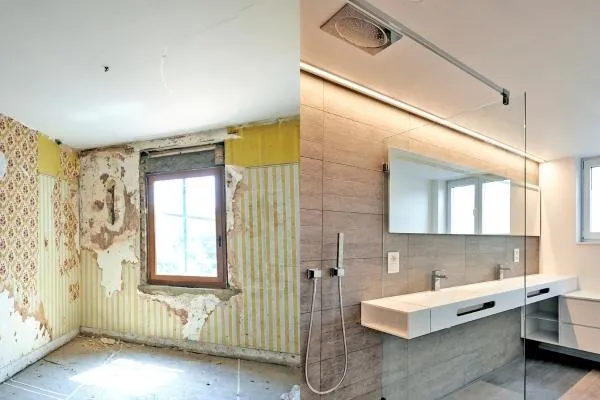07710 932885
Read our Blog

Bathroom Renovation Guide: From Start to Finish
Whether you're already planning a bathroom renovation or thinking about getting started, this guide will provide you with useful tips and advice to help you achieve your vision. From the initial planning stages to the final installation, we'll take you through each step of the bathroom renovation process.
Key Takeaways
Bathroom renovations can transform the look and functionality of your space.
Proper planning is essential for a successful bathroom renovation.
Hiring a professional builder can save you time and ensure all trades are coordinated effectively.
Choosing the right fixtures and fittings is crucial for achieving your desired bathroom design.
Removing the old bathroom and installing the new one requires skilled professionals.

Do I Need a Professional Builder for my Bathroom Renovation?
When it comes to bathroom renovation, hiring a professional builder can make all the difference. With several trades involved in bathroom fitting, including builders, tilers, electricians, and plumbers, having a professional builder oversee and project manage the installation can save you time and ensure that all the necessary trades are coordinated effectively.
Hiring professionals is particularly essential in scenarios such as installing a brand new bathroom, constructing or removing internal walls, or when building regulations approval is required. With experience in bathroom installation, a builder can handle all aspects of the project, including tiling, plumbing, and electrics, ensuring a smooth and efficient process from start to finish.
So, why should you consider hiring a professional builder for your bathroom renovation? Here are a few key reasons:
Expertise: A professional builder brings expertise to the project, ensuring that the renovation is carried out to the highest standards.
Coordination: Coordinating various trades can be challenging, but a builder can manage the process and ensure that everything runs smoothly.
Efficiency: With a professional overseeing the project, you can expect a faster turnaround time and efficient use of resources.
Quality Assurance: A builder can ensure that all the work meets building regulations and industry standards, providing you with peace of mind.
Hiring a professional can give you confidence that the project will be executed professionally and to your satisfaction.
How to Plan Your Bathroom Renovation
Planning is the most important step for a successful bathroom renovation. Before you start choosing fixtures and fittings, take the time to figure out how you want the space to function. Consider factors such as the location of plumbing and electrical connections, the size and layout of the bathroom, and who will be using the space.
To begin planning, start by sketching out different layouts on graph paper. Experiment with different placements of sanitaryware to find the most efficient and visually pleasing design. This will help you make informed decisions when it comes to selecting fixtures and fittings.
Considerations when planning your bathroom renovation:
The size of your bathroom: Is it a small ensuite or a large family bathroom? Understanding the dimensions of your space will help determine what can fit and what may need to be adjusted.
The location of plumbing and electrical connections: Keep in mind that moving plumbing and electrical connections can add to the complexity and cost of the renovation. Try to work around existing connections where possible.
Who will be using the space: Consider the needs of your household members. If you have children, you may need to include features that are safe and easy for them to use. If you have elderly family members, accessibility may be a priority.
Working with a builder during the planning stage can be extremely helpful. They can provide valuable insights and help you navigate any challenges that may arise. With their expertise, you can design your ideal bathroom that combines functionality and style.

Choosing the Right Fixtures and Fittings for Your Bathroom
When it comes to renovating your bathroom, one of the most important decisions you'll make is choosing the right fixtures and fittings. These elements not only contribute to the overall look of your space but also play a crucial role in its functionality. Here are some key points to consider when selecting bathroom fixtures and fittings.
Bathroom Fixtures:
The first step in choosing the right fixtures for your bathroom is to assess your needs and the size of your space. For smaller bathrooms, consider space-saving solutions such as wall-mounted toilets and compact vanities. If you have a larger bathroom, you may have more flexibility in terms of the size and style of fixtures you can choose.
When it comes to sanitaryware, there are a variety of options available, including toilets, basins, and showers. Think about the needs of your household and select fixtures that are durable, easy to clean, and fit your design aesthetic. Remember to also consider the water efficiency ratings of fixtures to conserve water and reduce your utility bills.
Bathroom Fittings:
Once you've chosen your fixtures, it's time to consider the fittings that will complement your design. Start by selecting a colour scheme for your bathroom. Whether you prefer a classic white-on-white look or a bold, colourful statement, the right fittings can enhance your chosen look.
Consider the type of material you want for your fittings. From chrome and stainless steel to brass and copper, each material can add a different touch to your bathroom. Choose fittings that are not only visually appealing but also durable and long-lasting.
Lighting and Ventilation:
Don't forget to also consider lighting and ventilation options for your bathroom. Lighting can greatly impact the feel of the space, so choose fixtures that provide enough task lighting as well as ambient lighting.
In terms of ventilation, proper airflow is essential to prevent moisture build-up and maintain a healthy environment. Consider installing an extractor fan or a window to ensure proper ventilation.
By carefully selecting the right fixtures and fittings for your bathroom, you can create a space that is not only visually stunning but also perfectly functional for your everyday needs.
Removing the Old and Installing the New
Once you have planned and chosen your fixtures and fittings, it's time to remove the old bathroom and install the new one. This step is a significant part of the renovation process and requires careful execution. Here's what you need to know:
Removal of Old Fixtures
The first task in this phase is to remove the old fixtures, including the toilet, basin, bathtub, and any cabinets or shelving. This process may involve disconnecting plumbing connections, dismantling the fixtures, and safely disposing of any debris. It's essential to take precautionary measures and use the appropriate tools to avoid damaging the bathroom structure during the removal process.
Wall and Floor Coverings
Next, you'll need to address the wall and floor coverings. This may include removing tiles, wallpaper, or paint from the walls and old flooring materials such as vinyl or laminate. Depending on the condition of the walls and floor, you may need to do some additional preparation work, such as filling in holes or repairing any damage before proceeding with the installation.
Plumbing and Electrical Work
During the removal and installation process, plumbing and electrical work will be crucial. This may involve relocating or replacing existing pipes, installing new fixtures, and ensuring that all connections are properly sealed and functioning. Similarly, electrical work may include rewiring, installing new lighting fixtures, and incorporating any additional electrical outlets required for your new bathroom layout.
Plumbing and electrical work requires qualified professionals to ensure compliance with building regulations and to guarantee the safety and efficiency of your bathroom's infrastructure. Find out more about Braviner's services and see how we can help.
By carefully removing the old bathroom and efficiently installing the new fixtures, walls, and floors, you are one step closer to achieving the bathroom of your dreams.

Setting a Budget for Your Bathroom Renovation
When taking on a bathroom renovation project, it is important to set a budget to ensure that your design aligns with your finances. By establishing a budget from the beginning, you can make informed decisions and avoid any unexpected costs or overspending along the way.
Consider all aspects of your bathroom renovation when determining your budget. This includes the cost of bathroom fixtures such as toilets, basins, showers, and taps. Research different suppliers to get an idea of pricing and compare options to find the best value for money without compromising on quality.
Labour rates are another important factor to consider. Hiring tradespeople such as fitters, plumbers, electricians, and decorators will incur additional costs. Research local labour rates to get an understanding of the average costs in your area. Keep in mind that experienced professionals may charge higher rates, but their expertise can ensure a smooth and high-quality renovation process.
It is also crucial to allow for some flexibility in your budget. Unexpected costs can arise during the renovation process, such as uncovering hidden issues or encountering structural challenges. By leaving some room in your budget for contingencies, you can handle these surprises without derailing the entire project.
How Long Will a Bathroom Renovation Take?
One of the most common questions when it comes to bathroom renovations is how long the process will take. While every project is unique and the timeline can vary, it's essential to have a general idea of the duration to plan accordingly.
On average, a standard-sized bathroom renovation can take around two weeks to complete. However, it's important to note that this timeline can be extended if there are significant structural changes or extensive plumbing and electrical work involved.
When estimating the timeline for your bathroom makeover, it's important to consider all the necessary steps in the renovation process. This includes planning, sourcing materials, demolition, installation of fixtures and fittings, plumbing and electrical work, tiling, and finishing touches. Each of these stages requires time and coordination to ensure a smooth and successful renovation.
It's advisable to communicate with your builder or tradespeople to get a more accurate estimate of the timeline for your specific project. They have the experience and expertise to assess the scope of work and provide you with a realistic timeframe. It's also essential to allow some flexibility in your schedule as unforeseen complications or delays can arise during the renovation process.
Factors Influencing the Timeline
The duration of a bathroom renovation is influenced by various factors. These include:
The complexity of the project: If your renovation involves major structural changes or the relocation of plumbing and electrical connections, it will naturally take longer to complete.
The availability of materials: Depending on the specific fixtures and fittings you choose, there may be lead times for sourcing these items. It's important to factor in the time it takes to receive the materials before the installation can begin.
The size of the bathroom: Larger bathrooms may require more time for demolition, installation, and finishing touches compared to smaller ones.
The efficiency of the tradespeople involved: Hiring experienced professionals who work efficiently can help streamline the renovation process and potentially shorten the timeline.
By considering these factors and working closely with your builder or tradespeople, you can get a better understanding of the timeline for your bathroom renovation project. Patience and flexibility are key during this process, as the end result will be a beautifully transformed bathroom that meets your needs and exceeds your expectations.
Conclusion
Embarking on a bathroom renovation is an exciting journey that requires careful planning and consideration. By following the steps outlined in this guide and working with experienced professionals, you can achieve the bathroom of your dreams.
Remember to set a realistic budget and choose the right fixtures and fittings that complement your design vision. Collaborating with a professional builder can save you time and ensure that all the necessary trades are coordinated effectively.
Allow for the necessary time to complete the renovation, as the duration can vary depending on the scope of the project. Communicate with your builder or tradespeople to get a realistic estimate of the timeline for your specific project. With proper planning and expert guidance, your bathroom transformation will be a success.
FAQ
Do I need a professional builder for my bathroom renovation?
Hiring a professional builder who can oversee and project manage the bathroom installation can save you time and ensure that all the necessary trades are coordinated effectively. Using a builder may be necessary in scenarios such as installing a brand new bathroom, constructing or removing internal walls, or when building regulations approval is required.
How do I plan my bathroom renovation?
Before you start choosing fixtures and fittings, take the time to evaluate your needs and envision how you want the space to function. Consider factors such as the location of plumbing and electrical connections, the size and layout of the bathroom, and who will be using the space. Utilize graph paper to sketch out different layouts and experiment with different placements of sanitaryware.
How do I choose the right fixtures and fittings for my bathroom?
Consider factors such as the size of your bathroom and the needs of its users when selecting sanitaryware, including toilets, basins, and showers. Think about the style and colour scheme you want to achieve and select tiles, wall boards, and flooring materials that complement your design vision. Don't forget to also consider lighting and ventilation options to enhance the ambiance of your bathroom.
How do I remove the old bathroom and install the new one?
This step may involve the removal of old fixtures, wall and floor coverings, and even some minor building work. Plumbing and electrical work will also need to be carried out to ensure that all connections are properly installed. It's important to work with experienced professionals for these tasks to ensure safety and compliance with building regulations.
How do I set a budget for my bathroom renovation?
Consider the cost of the fixtures and fittings you want to include in your bathroom and research different suppliers to get an idea of pricing. Don't forget to factor in labour rates for tradespeople such as fitters, plumbers, electricians, and decorators. Be realistic about your budget and allow for some flexibility in case unexpected costs arise during the renovation process.
How long will a bathroom renovation take?
The duration of a bathroom renovation can vary depending on the scope of the project and any unforeseen complications. On average, a standard-sized bathroom renovation can take around two weeks to complete. However, this timeline can be extended if major structural changes or extensive plumbing and electrical work are involved. It's important to communicate with your builder or tradespeople to get a realistic estimate of the timeline for your specific project.
Source Links
Read our Blog

Bathroom Renovation Guide: From Start to Finish
Whether you're already planning a bathroom renovation or thinking about getting started, this guide will provide you with useful tips and advice to help you achieve your vision. From the initial planning stages to the final installation, we'll take you through each step of the bathroom renovation process.
Key Takeaways
Bathroom renovations can transform the look and functionality of your space.
Proper planning is essential for a successful bathroom renovation.
Hiring a professional builder can save you time and ensure all trades are coordinated effectively.
Choosing the right fixtures and fittings is crucial for achieving your desired bathroom design.
Removing the old bathroom and installing the new one requires skilled professionals.

Do I Need a Professional Builder for my Bathroom Renovation?
When it comes to bathroom renovation, hiring a professional builder can make all the difference. With several trades involved in bathroom fitting, including builders, tilers, electricians, and plumbers, having a professional builder oversee and project manage the installation can save you time and ensure that all the necessary trades are coordinated effectively.
Hiring professionals is particularly essential in scenarios such as installing a brand new bathroom, constructing or removing internal walls, or when building regulations approval is required. With experience in bathroom installation, a builder can handle all aspects of the project, including tiling, plumbing, and electrics, ensuring a smooth and efficient process from start to finish.
So, why should you consider hiring a professional builder for your bathroom renovation? Here are a few key reasons:
Expertise: A professional builder brings expertise to the project, ensuring that the renovation is carried out to the highest standards.
Coordination: Coordinating various trades can be challenging, but a builder can manage the process and ensure that everything runs smoothly.
Efficiency: With a professional overseeing the project, you can expect a faster turnaround time and efficient use of resources.
Quality Assurance: A builder can ensure that all the work meets building regulations and industry standards, providing you with peace of mind.
Hiring a professional can give you confidence that the project will be executed professionally and to your satisfaction.
How to Plan Your Bathroom Renovation
Planning is the most important step for a successful bathroom renovation. Before you start choosing fixtures and fittings, take the time to figure out how you want the space to function. Consider factors such as the location of plumbing and electrical connections, the size and layout of the bathroom, and who will be using the space.
To begin planning, start by sketching out different layouts on graph paper. Experiment with different placements of sanitaryware to find the most efficient and visually pleasing design. This will help you make informed decisions when it comes to selecting fixtures and fittings.
Considerations when planning your bathroom renovation:
The size of your bathroom: Is it a small ensuite or a large family bathroom? Understanding the dimensions of your space will help determine what can fit and what may need to be adjusted.
The location of plumbing and electrical connections: Keep in mind that moving plumbing and electrical connections can add to the complexity and cost of the renovation. Try to work around existing connections where possible.
Who will be using the space: Consider the needs of your household members. If you have children, you may need to include features that are safe and easy for them to use. If you have elderly family members, accessibility may be a priority.
Working with a builder during the planning stage can be extremely helpful. They can provide valuable insights and help you navigate any challenges that may arise. With their expertise, you can design your ideal bathroom that combines functionality and style.

Choosing the Right Fixtures and Fittings for Your Bathroom
When it comes to renovating your bathroom, one of the most important decisions you'll make is choosing the right fixtures and fittings. These elements not only contribute to the overall look of your space but also play a crucial role in its functionality. Here are some key points to consider when selecting bathroom fixtures and fittings.
Bathroom Fixtures:
The first step in choosing the right fixtures for your bathroom is to assess your needs and the size of your space. For smaller bathrooms, consider space-saving solutions such as wall-mounted toilets and compact vanities. If you have a larger bathroom, you may have more flexibility in terms of the size and style of fixtures you can choose.
When it comes to sanitaryware, there are a variety of options available, including toilets, basins, and showers. Think about the needs of your household and select fixtures that are durable, easy to clean, and fit your design aesthetic. Remember to also consider the water efficiency ratings of fixtures to conserve water and reduce your utility bills.
Bathroom Fittings:
Once you've chosen your fixtures, it's time to consider the fittings that will complement your design. Start by selecting a colour scheme for your bathroom. Whether you prefer a classic white-on-white look or a bold, colourful statement, the right fittings can enhance your chosen look.
Consider the type of material you want for your fittings. From chrome and stainless steel to brass and copper, each material can add a different touch to your bathroom. Choose fittings that are not only visually appealing but also durable and long-lasting.
Lighting and Ventilation:
Don't forget to also consider lighting and ventilation options for your bathroom. Lighting can greatly impact the feel of the space, so choose fixtures that provide enough task lighting as well as ambient lighting.
In terms of ventilation, proper airflow is essential to prevent moisture build-up and maintain a healthy environment. Consider installing an extractor fan or a window to ensure proper ventilation.
By carefully selecting the right fixtures and fittings for your bathroom, you can create a space that is not only visually stunning but also perfectly functional for your everyday needs.
Removing the Old and Installing the New
Once you have planned and chosen your fixtures and fittings, it's time to remove the old bathroom and install the new one. This step is a significant part of the renovation process and requires careful execution. Here's what you need to know:
Removal of Old Fixtures
The first task in this phase is to remove the old fixtures, including the toilet, basin, bathtub, and any cabinets or shelving. This process may involve disconnecting plumbing connections, dismantling the fixtures, and safely disposing of any debris. It's essential to take precautionary measures and use the appropriate tools to avoid damaging the bathroom structure during the removal process.
Wall and Floor Coverings
Next, you'll need to address the wall and floor coverings. This may include removing tiles, wallpaper, or paint from the walls and old flooring materials such as vinyl or laminate. Depending on the condition of the walls and floor, you may need to do some additional preparation work, such as filling in holes or repairing any damage before proceeding with the installation.
Plumbing and Electrical Work
During the removal and installation process, plumbing and electrical work will be crucial. This may involve relocating or replacing existing pipes, installing new fixtures, and ensuring that all connections are properly sealed and functioning. Similarly, electrical work may include rewiring, installing new lighting fixtures, and incorporating any additional electrical outlets required for your new bathroom layout.
Plumbing and electrical work requires qualified professionals to ensure compliance with building regulations and to guarantee the safety and efficiency of your bathroom's infrastructure. Find out more about Braviner's services and see how we can help.
By carefully removing the old bathroom and efficiently installing the new fixtures, walls, and floors, you are one step closer to achieving the bathroom of your dreams.

Setting a Budget for Your Bathroom Renovation
When taking on a bathroom renovation project, it is important to set a budget to ensure that your design aligns with your finances. By establishing a budget from the beginning, you can make informed decisions and avoid any unexpected costs or overspending along the way.
Consider all aspects of your bathroom renovation when determining your budget. This includes the cost of bathroom fixtures such as toilets, basins, showers, and taps. Research different suppliers to get an idea of pricing and compare options to find the best value for money without compromising on quality.
Labour rates are another important factor to consider. Hiring tradespeople such as fitters, plumbers, electricians, and decorators will incur additional costs. Research local labour rates to get an understanding of the average costs in your area. Keep in mind that experienced professionals may charge higher rates, but their expertise can ensure a smooth and high-quality renovation process.
It is also crucial to allow for some flexibility in your budget. Unexpected costs can arise during the renovation process, such as uncovering hidden issues or encountering structural challenges. By leaving some room in your budget for contingencies, you can handle these surprises without derailing the entire project.
How Long Will a Bathroom Renovation Take?
One of the most common questions when it comes to bathroom renovations is how long the process will take. While every project is unique and the timeline can vary, it's essential to have a general idea of the duration to plan accordingly.
On average, a standard-sized bathroom renovation can take around two weeks to complete. However, it's important to note that this timeline can be extended if there are significant structural changes or extensive plumbing and electrical work involved.
When estimating the timeline for your bathroom makeover, it's important to consider all the necessary steps in the renovation process. This includes planning, sourcing materials, demolition, installation of fixtures and fittings, plumbing and electrical work, tiling, and finishing touches. Each of these stages requires time and coordination to ensure a smooth and successful renovation.
It's advisable to communicate with your builder or tradespeople to get a more accurate estimate of the timeline for your specific project. They have the experience and expertise to assess the scope of work and provide you with a realistic timeframe. It's also essential to allow some flexibility in your schedule as unforeseen complications or delays can arise during the renovation process.
Factors Influencing the Timeline
The duration of a bathroom renovation is influenced by various factors. These include:
The complexity of the project: If your renovation involves major structural changes or the relocation of plumbing and electrical connections, it will naturally take longer to complete.
The availability of materials: Depending on the specific fixtures and fittings you choose, there may be lead times for sourcing these items. It's important to factor in the time it takes to receive the materials before the installation can begin.
The size of the bathroom: Larger bathrooms may require more time for demolition, installation, and finishing touches compared to smaller ones.
The efficiency of the tradespeople involved: Hiring experienced professionals who work efficiently can help streamline the renovation process and potentially shorten the timeline.
By considering these factors and working closely with your builder or tradespeople, you can get a better understanding of the timeline for your bathroom renovation project. Patience and flexibility are key during this process, as the end result will be a beautifully transformed bathroom that meets your needs and exceeds your expectations.
Conclusion
Embarking on a bathroom renovation is an exciting journey that requires careful planning and consideration. By following the steps outlined in this guide and working with experienced professionals, you can achieve the bathroom of your dreams.
Remember to set a realistic budget and choose the right fixtures and fittings that complement your design vision. Collaborating with a professional builder can save you time and ensure that all the necessary trades are coordinated effectively.
Allow for the necessary time to complete the renovation, as the duration can vary depending on the scope of the project. Communicate with your builder or tradespeople to get a realistic estimate of the timeline for your specific project. With proper planning and expert guidance, your bathroom transformation will be a success.
FAQ
Do I need a professional builder for my bathroom renovation?
Hiring a professional builder who can oversee and project manage the bathroom installation can save you time and ensure that all the necessary trades are coordinated effectively. Using a builder may be necessary in scenarios such as installing a brand new bathroom, constructing or removing internal walls, or when building regulations approval is required.
How do I plan my bathroom renovation?
Before you start choosing fixtures and fittings, take the time to evaluate your needs and envision how you want the space to function. Consider factors such as the location of plumbing and electrical connections, the size and layout of the bathroom, and who will be using the space. Utilize graph paper to sketch out different layouts and experiment with different placements of sanitaryware.
How do I choose the right fixtures and fittings for my bathroom?
Consider factors such as the size of your bathroom and the needs of its users when selecting sanitaryware, including toilets, basins, and showers. Think about the style and colour scheme you want to achieve and select tiles, wall boards, and flooring materials that complement your design vision. Don't forget to also consider lighting and ventilation options to enhance the ambiance of your bathroom.
How do I remove the old bathroom and install the new one?
This step may involve the removal of old fixtures, wall and floor coverings, and even some minor building work. Plumbing and electrical work will also need to be carried out to ensure that all connections are properly installed. It's important to work with experienced professionals for these tasks to ensure safety and compliance with building regulations.
How do I set a budget for my bathroom renovation?
Consider the cost of the fixtures and fittings you want to include in your bathroom and research different suppliers to get an idea of pricing. Don't forget to factor in labour rates for tradespeople such as fitters, plumbers, electricians, and decorators. Be realistic about your budget and allow for some flexibility in case unexpected costs arise during the renovation process.
How long will a bathroom renovation take?
The duration of a bathroom renovation can vary depending on the scope of the project and any unforeseen complications. On average, a standard-sized bathroom renovation can take around two weeks to complete. However, this timeline can be extended if major structural changes or extensive plumbing and electrical work are involved. It's important to communicate with your builder or tradespeople to get a realistic estimate of the timeline for your specific project.
Source Links
© 2023. All rights reserved by Braviner Construction ltd. Powered by MSM Marketing






